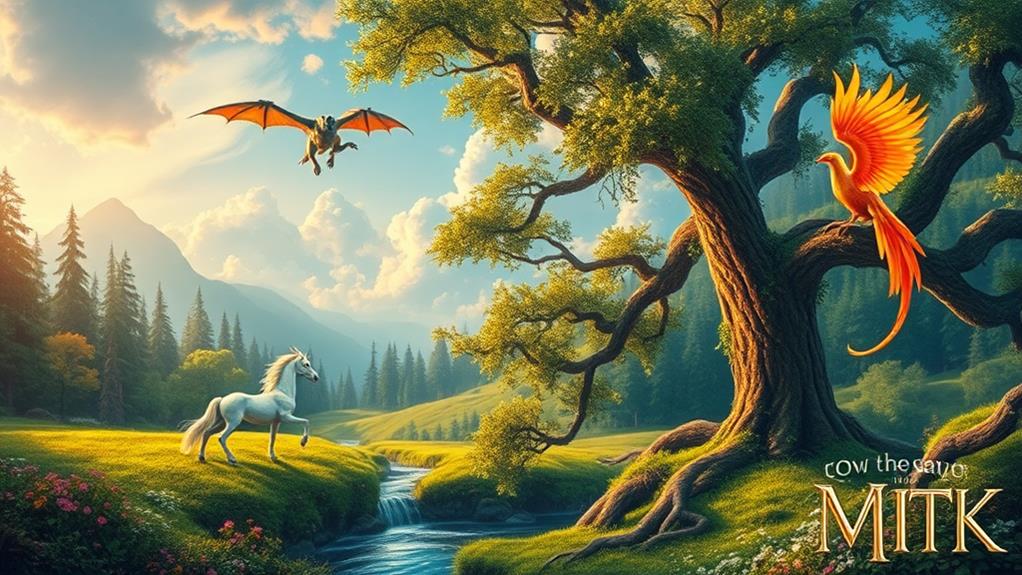
Fantasy creatures like dragons, unicorns, and mermaids captivate your imagination with their magic and mystery. Dragons symbolize power and wisdom in Chinese mythology, while European lore paints them as chaotic and evil. Unicorns represent purity and grace, enchanting you with their ethereal beauty. Mermaids mesmerize with their enchanting allure and connection to the ocean. Phoenixes symbolize rebirth and resilience, rising from their ashes, while werewolves embody the struggle between human nature and primal instincts. Fairies and vampires add elegance and supernatural fascination. Griffins, centaurs, and golems also offer intriguing tales. There's always more to explore in this fantastic domain.
Dragons
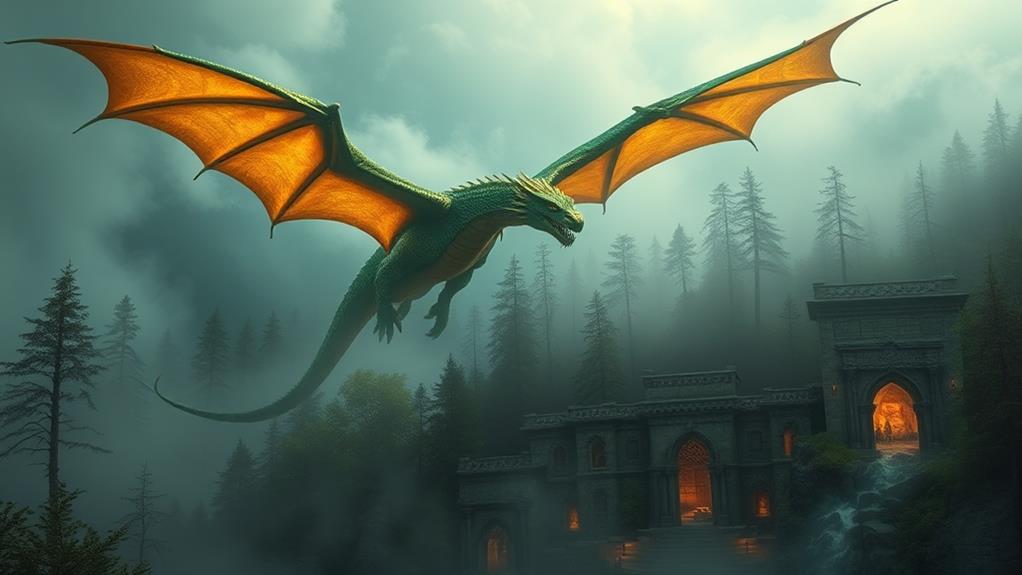
Dragons, those awe-inspiring titans of myth and legend, have captured human imagination for centuries. You can't help but marvel at their majestic presence, whether they're depicted as wise, benevolent protectors or fierce, destructive forces. Across cultures, dragons take varied forms, boasting scales, wings, and the ability to breathe fire.
In European folklore, dragons often symbolize chaos and evil, appearing in tales where knights set out on perilous quests to slay these formidable beasts. On the other hand, Chinese mythology paints dragons as noble creatures, embodying power, luck, and wisdom. These dragons are associated with water and weather, believed to bring rain and prosperity.
When you dig into modern fantasy, dragons continue to hold a prominent place. Think of J.R.R. Tolkien's Smaug in "The Hobbit" or Daenerys Targaryen's dragons in "Game of Thrones." These stories bring dragons to life, showcasing their might and grandeur, allowing you to explore their complex relationships with humans.
You can't deny that dragons remain a cornerstone of fantasy literature and popular culture. Their enduring legacy speaks to a universal fascination with these mythical creatures, blending fear and admiration in equal measure.
Unicorns
Among the pantheon of fantastical beings, unicorns stand out as symbols of purity and grace. You'll often find them depicted as ethereal white horses with a single, spiraling horn on their foreheads. These creatures are not just enchanting; they embody innocence and magic, making them timeless icons in folklore and mythology.
Unicorns are believed to possess healing powers. Their horn, known as an alicorn, is said to purify water and neutralize poison. Imagine stumbling upon a unicorn in an enchanted forest; legends suggest it could cleanse your soul and grant you protection against evil. You might feel an overwhelming sense of peace and wonder in its presence.
You'll notice unicorns frequently appear in medieval literature and tapestries, often associated with maidens and virginity. The creature's elusive nature makes it a symbol of something pure and unattainable. In many stories, only the pure of heart can capture or tame a unicorn, underscoring its connection to virtue.
Unicorns continue to captivate modern pop culture, appearing in books, movies, and art. Their enduring appeal lies in their blend of elegance and mysticism, offering you a glimpse into a world where magic and wholesomeness reign supreme.
Phoenixes
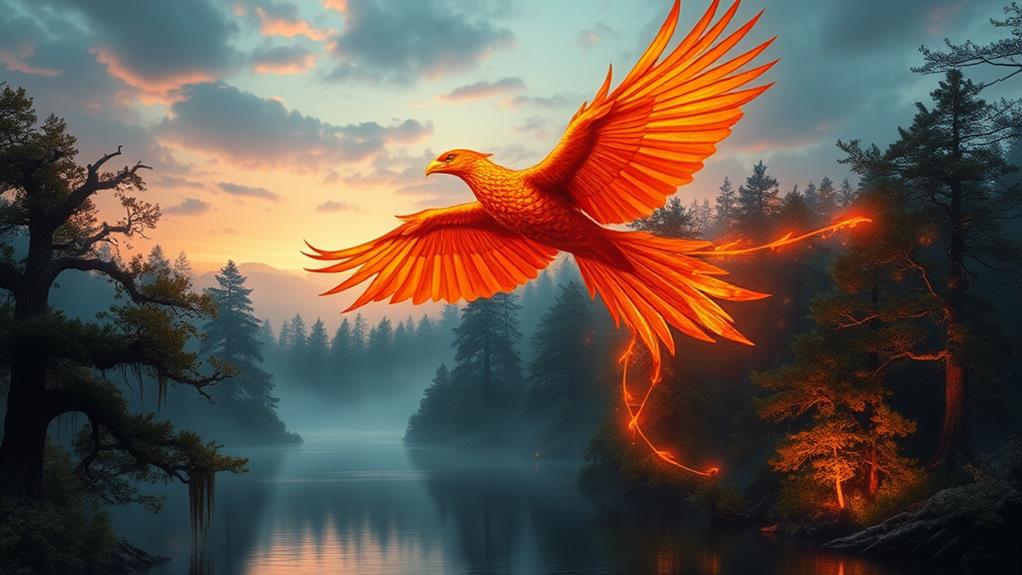
While unicorns symbolize purity and grace, phoenixes embody the essence of rebirth and resilience. When you think of a phoenix, you probably picture a magnificent bird engulfed in flames, rising from its own ashes. This legendary creature has fascinated cultures for centuries, symbolizing the idea that from destruction comes renewal.
In mythology, the phoenix is often associated with the sun, its life cycle mirroring the daily setting and rising of the celestial body. Every few centuries, this immortal bird builds a nest, ignites it, and is consumed by fire, only to emerge reborn. This process highlights the theme of transformation and the inevitability of change, reminding you that endings can lead to new beginnings.
You can find the phoenix in various cultural myths, from Ancient Egypt to Greek and Roman legends. Each portrayal adds unique elements but maintains the core theme of rebirth. Beyond mythology, the phoenix continues to inspire literature, film, and art, representing hope and the human spirit's ability to overcome adversity.
Griffins
Griffins, with their majestic lion bodies and eagle heads, captivate the imagination like few other mythical creatures. These awe-inspiring beings symbolize strength, courage, and guardianship, often depicted as protectors of priceless treasures and ancient secrets. You can't help but feel a sense of wonder when you envision a griffin soaring through the sky, its powerful wings beating against the wind.
In many mythologies, griffins are revered as noble and wise, embodying the best traits of both the lion and the eagle. The lion's body provides them with unmatched strength and ferocity, while the eagle's head and wings grant them keen vision and the ability to traverse great distances swiftly. This combination makes griffins formidable adversaries and invaluable allies.
You'll find griffins in various cultures, from ancient Greek mythology to medieval heraldry. They often appear on coats of arms, symbolizing vigilance and valor. In literature and modern fantasy, griffins continue to enchant readers and viewers, embodying the timeless appeal of hybrid creatures that blend the terrestrial and the aerial.
Encountering a griffin in a story or artwork stirs your sense of adventure, inviting you to explore worlds where the extraordinary becomes possible.
Mermaids
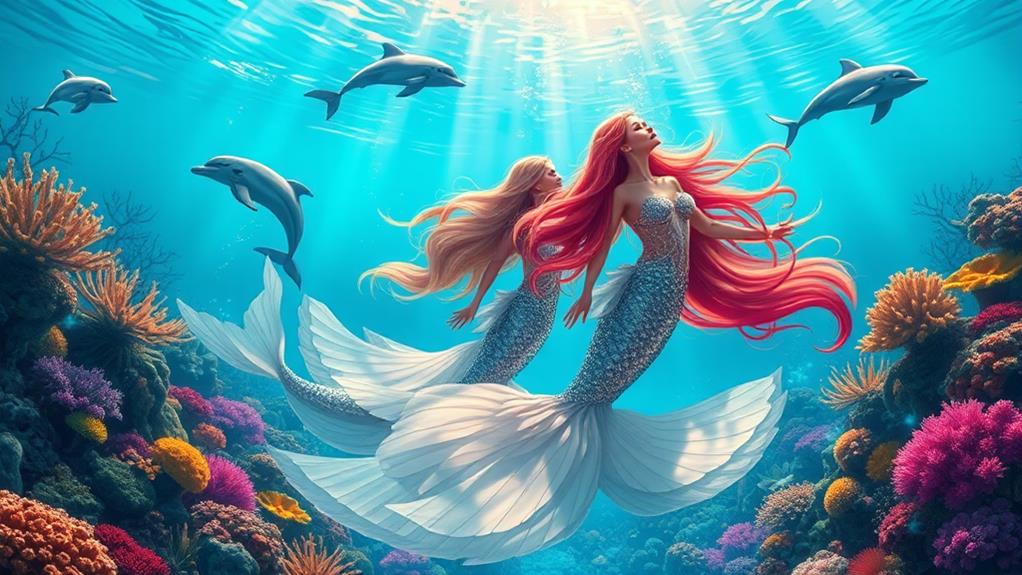
Beneath the shimmering surface of the ocean, mermaids captivate the imagination with their enchanting beauty and mysterious allure. Picture yourself swimming alongside these mythical beings, their iridescent tails glimmering like jewels under the water. Mermaids have fascinated humans for centuries, appearing in folklore and mythology across diverse cultures.
You'll find that mermaids are often depicted as guardians of the sea, possessing the ability to communicate with marine creatures and control the ocean's waves. Their dual nature, part human and part fish, symbolizes a bridge between the terrestrial and aquatic worlds. This duality makes them both approachable and enigmatic.
In stories, mermaids are known to sing hauntingly beautiful songs that can either lure sailors to their doom or guide them safely through treacherous waters. These creatures embody both the peril and the promise of the ocean, making them endlessly intriguing.
When you explore mermaid lore, you'll discover tales of love, betrayal, and transformation. Whether they're depicted as benevolent or malevolent, mermaids remain a powerful symbol of the ocean's endless mysteries. So next time you gaze out at the sea, imagine the secret world that might lie just beneath the waves, teeming with mermaid magic.
Centaurs
As you leave the enchanting world of mermaids behind, turn your gaze to the rugged landscapes where centaurs roam. These majestic beings, half-human and half-horse, captivate your imagination with their unique blend of strength and wisdom. Centaurs often dwell in dense forests or open plains, embodying the essence of freedom and wild nature.
You'll find that centaurs possess remarkable intelligence and are skilled in archery, astronomy, and healing. Their dual nature symbolizes the harmony between human intellect and animal instincts. In many legends, centaurs serve as guardians of ancient knowledge, offering guidance to those who seek it.
Centaurs are known for their fierce loyalty and protective instincts. They form tight-knit communities, valuing family and tradition. Despite their wild appearance, centaurs often operate under a strict code of honor, making them both formidable allies and fearsome adversaries.
When you encounter a centaur in literature or film, notice their complex personalities. They're not just brutes or sages; they're a blend of both, reflecting the duality inherent in all beings. Centaurs invite you to explore the balance between civilization and the untamed wilderness.
Werewolves

The moonlight casts an eerie glow as you step into the shadowy domain of werewolves. These legendary shapeshifters, often humans by day, transform into powerful, fearsome wolves under the full moon. The lore surrounding werewolves stretches back to ancient times, with tales from Greek mythology to medieval Europe painting vivid pictures of their terrifying prowess and primal nature.
You might imagine the transformation as a painful, bone-cracking process, where human features warp into lupine ones. Werewolves are typically portrayed with heightened senses, incredible strength, and an insatiable hunger. This makes them both fascinating and fearsome figures in folklore and modern fantasy.
In literature and film, werewolves often symbolize the struggle between civilization and wildness, control and chaos. Classic stories like "The Wolf Man" and modern adaptations such as "Teen Wolf" explore these themes, allowing you to explore the duality of human nature. Despite their monstrous forms, werewolves often evoke sympathy, embodying the inner battles everyone faces.
Whether in the heart of a dark forest or the streets of a bustling city, werewolves captivate our imaginations by blending the human and the beastly, the familiar and the unknown.
Fairies
Leaving behind the primal intensity of werewolves, you now enter the enchanting domain of fairies. These delicate, winged beings are often depicted as guardians of nature, flourishing in lush forests and serene meadows. Unlike the fierce werewolf, fairies embody elegance and grace, their very presence often associated with magic and ethereal beauty.
You'll find fairies in countless myths and legends worldwide, from the Irish Aos Sí to the Hindu apsaras. They're known for their trickster tendencies, sometimes leading travelers astray or playing harmless pranks. Yet, they can also be benevolent, bestowing blessings and good fortune on those who respect their environment.
Fairies often have a deep connection to elements like earth, water, and air. Their powers can include flight, invisibility, and the ability to manipulate natural elements. In literature and media, they range from the tiny, mischievous Tinker Bell to the majestic, powerful beings in works like "A Midsummer Night's Dream."
Interacting with fairies requires caution and respect. They're not just whimsical creatures; they hold immense power and ancient wisdom. Treat them well, and you might find yourself in their favor. Disrespect them, and you could face their unpredictable wrath.
Vampires
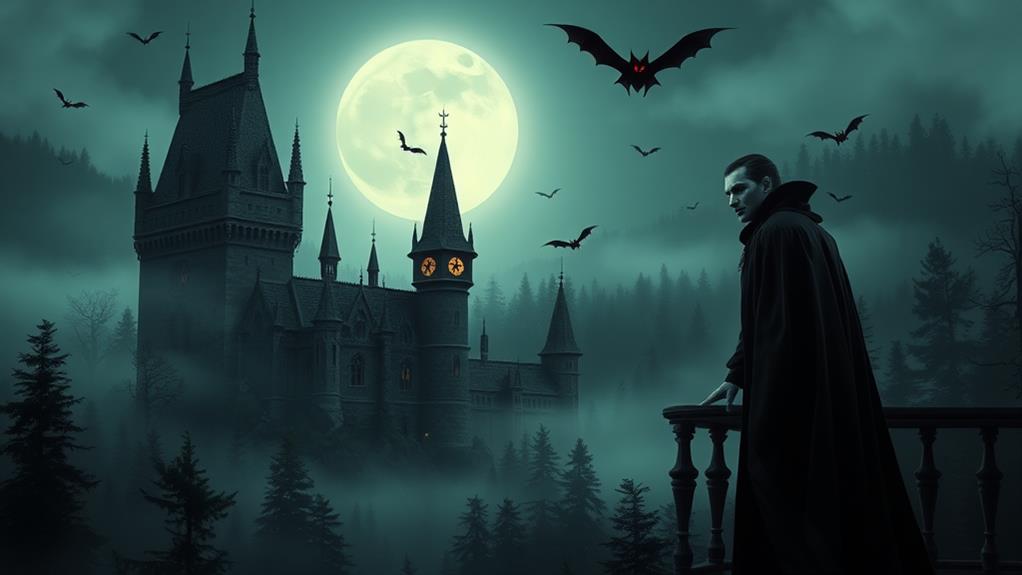
When you plunge into the dark domain of vampires, you'll encounter some of the most enchanting and feared creatures of myth and legend. These bloodthirsty beings, often depicted with pale skin and fangs, captivate our imaginations with their immortality and supernatural allure. They've been a staple in folklore for centuries, appearing in tales from diverse cultures, each adding unique twists to their horrifying charm.
In European legends, vampires are often portrayed as aristocratic figures, lurking in shadowy castles, preying on the unsuspecting. The most famous of these is Count Dracula, a character that has defined modern vampire lore. You'll find that vampires are often associated with themes of seduction and danger, their bite both a curse and a dark gift.
Modern portrayals of vampires vary widely. From the sophisticated and brooding to the monstrous and feral, they can embody a range of characteristics. In popular culture, they often navigate the fine line between humanity and monstrosity, making them endlessly fascinating. Whether they're heroes or villains, vampires continue to enthrall audiences, leaving you to ponder the nature of immortality and the eternal struggle between light and dark.
Golems
While vampires haunt the night with their allure and terror, golems stand as silent guardians molded from clay or stone. You'll find these fascinating creatures rooted in Jewish folklore, where they're often created by a rabbi to protect a community. Their imposing forms and unwavering loyalty make them the epitome of steadfast defenders.
Golems are brought to life through ancient rituals and inscriptions, often involving sacred words or symbols. Imagine the awe and responsibility you'd feel animating such a powerful being. Yet, they're not without their limitations. Lacking free will, golems follow commands to the letter, which can sometimes lead to unintended consequences.
Here's a quick overview to pique your curiosity:
| Aspect | Description | Example in Media |
|---|---|---|
| Origin | Jewish folklore | The Golem of Prague |
| Material | Usually clay or stone | Clay in "The Golem" (1915 film) |
| Purpose | Protection or labor | Golem servants in "Discworld" |
| Weakness | Can be deactivated through specific rituals | Removal of the sacred word |
Golems offer a unique blend of mysticism and raw power. Their stories plumb into themes of creation, control, and the ethical implications of wielding such formidable beings.
At a Glance
In the domain of fantasy, you've encountered creatures that ignite your imagination and stir your soul. Dragons breathe fire, while unicorns embody purity. Phoenixes rise from ashes, and griffins guard ancient treasures. Mermaids enchant the seas, and werewolves haunt the night. Fairies bring magic to the mundane, and vampires challenge our fears. Golems remind us of human folly and power. Isn't it thrilling to wonder what other marvels await in the endless world of fantasy?





